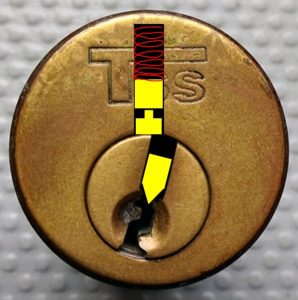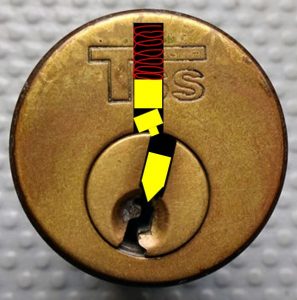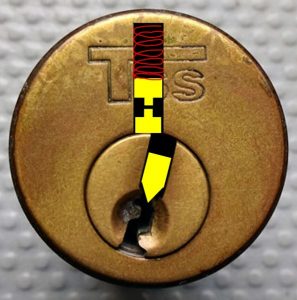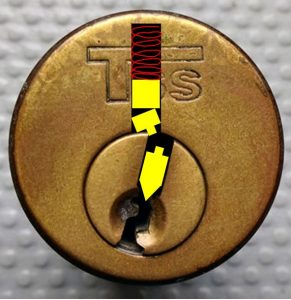
Schlage introduced T-Pins as an anti-bump measure and you have probably seen obscure references to them in the Schlage re-keying manuals. I’m not certain how successful T-pins were as a bump protection measure, but I can say that they are some of the most devious, and difficult-to-pick pins that you will face. There are four different configurations that I’ve seen these used in, some are pretty easy to pick, while a couple of the others ARE ABSOLUTE HELL.
The first is in factory pinned Schlage locks as the standard anti-bump pin. When sandwiched between the key pin and a driver pin, it is positioned to transfer any energy from the key pin to the driver. When used with a key, the T-pin is transparent – it simply links the two pins. When we try to use a bump key however, the T-pin acts very much like multiple colliding pool balls. As the bump key strikes the key pin, the kinetic energy transfers from the key to the key pin. In locks with no T-Pin, the key pin’s kinetic energy transfers to the driver pin, making it recoil against the spring tension. This is what makes bumping possible. However, with the T-Pin installed, the key pin’s energy transfers to the t-pin, then to the driver pin. The driver pin does recoil against the spring’s tension, but once the T-pin transfers it’s energy, it remains in the shear line, blocking the core. The principle is precisely what happens when two or more pool balls collide. When the moving ball strikes a second, the first stops in place and the second absorbs the remaining energy.
Locks containing a T-pin in this configuration are not difficult to pick. In fact, the additional shear line offered by the additional pin makes it a bit easier to pick, provided the tip of the T doesn’t hang up in the shear line. If it does, you can usually find the offending chamber by feeling around with a hook. The feedback you’ll receive is exactly like you’d get from a spool pin. In fact, you’ll probably never even know you were facing a T-pin, because you’ll handle a stuck t-pin precisely like a spool. Once it clears the shear line, you’re done with it.

The SECOND configuration is a little more devious. The T-pin is still sandwiched between the key pin and driver pin, but is installed with the tip of the T pointing towards the key. This will still frustrate bumping and kinetic attacks, but has an added cabability: it will piss you off. You’ll pick the lock and SWEAR every single pin is picked, and it ALMOST is, but how will you know? Well, by the time you’ve reached this level of picking you’ll be pretty confident the pins are picked, but experienced enough to realize that something is hung up at the shear line. You’ll feel all of the key pins sitting sedately at the bottom of the keyway – none under spring tension, so you know they’re probably picked. Of course, it is possible that you’ve overset something, but by the time you get this far that’s probably not the case, so you test the pins using a hook. You are looking for some feedback, of course, hopefully some counter-rotation indicating a spool hung up – which you can easily pick. If there’s no counter-rotation, you can be pretty sure some SOB installed an upside down T-pin. To beat it, loosen up on your tension and move from pin to pin with a hook trying to break the tip of the T-pin loose from the shear line. It’s risky and you’ll really need to carefully regulate your tension or you’ll end up dropping some pins or oversetting something.

The THIRD configuration IS devious. The first time I saw this was in a challenge lock I received from FarmerFreak, a lock builder known for his creativity and imagination. FarmerFreak installed TWO opposing T-pins in each cylinder with no driver pin and coined the term “Drunken Spools”, and that is exactly how they act. When the first T-pin clears the shear line you get your “click” and slight turn on the core, making you believe you have a spool. What you DON’T know is the leg of the top t-pin is hanging in the shear line, preventing an open. Making matters worse for you, the bottom T-pin’s leg is now wedged against the ledge of the partially turned shear line. No amount of pressure with your pick will set it, and I’ve broken many picks to prove that. Drunken spools don’t come in factory locks, thank goodness, only challenge locks. So if you feel that you’ve encountered one you’ll need to let off on your tension to reduce the size of the ledge that the bottom pin is wedged against, jiggle your hook against the bottom pin in hopes of sliding the bottom t-pin past the shear line. You’ll know the moment you manage to do this because it will feel EXACTLY like a spool pin, and picks pretty easily from that point. However…. if your lock builder is like FarmerFreak and was in a particularly nasty mood when building your lock, there are probably MORE drunken spools and, as we all know – spools must be picked in a specific sequence. Prepare to spend some time with that lock setting and unsetting drunken spools as you try to find the correct binding order. Good luck, you’ll need it with these.

The FOURTH configuration is actually a compliment to the success of the T-pin. It started as hobbyists took a standard key pin and thinned the top to varying thicknesses. This is nasty because as the thinned part reaches the shear line you’ll get the characteristic false set, very similar to a spool pin. Then, depending on how thin the top of the pin is, and how sharp the edges, it can be VERY difficult to clear from the shear line. Again, treat it like a spool but expect it to be a bit harder to pick through the shear line. Abus, Winkhaus and Zeiss have all started using reduced diameter key pins in their locks, guaranteeing that our picking hobby will get more challenging as time goes on. I have even started seeing challenge locks that use these reduced diameter key pins used with inverted standard t-pins. Next I expect someone to install a drunken spool above something like this… Interesting times ahead!